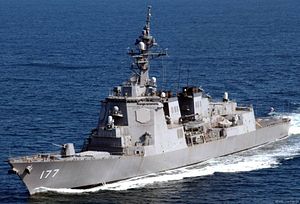On August 7, the U.S. Defense Security Cooperation Agency (DSCA) announced that the U.S. State Department has approved a possible $1.5 billion sale of two Lockheed Martin Corp Aegis combat systems as well as new anti-submarine warfare equipment to Japan. According to the DSCA press release:
The Government of Japan has requested a possible sale of two (2) ship sets of the MK 7 AEGIS Weapon System, AN/SQQ-89A (v) 15J UWS and CEC. Additional items include associated equipment, training, and support for its Japan Fiscal Year (JFY) 2015 and JFY2016 new construction destroyers (DDGs). The ACS and associated support will be procured over a six (6) to seven (7) year period, as approved by Japan in budgets for JFY2015 and JFY2016.
The weapons deal, likely to be approved by Congress, aims to enhance Japan’s capabilities to defend against a ballistic missile attack. Japan is currently upgrading and modifying all of its Aegis destroyers (the Kongō-class and Atago-class) with the Aegis ballistic missile defense (BMD) system.
In November 2013, the Japanese government announced that it would procure two additional Atago-class vessels, equipped with the Aegis-BMD system, to be commissioned in 2020 and 2021 respectively.
“The addition of two (2) new AEGIS DDGs will fulfill Japan’s mission goal of acquiring eight (8) ballistic missile defense capable ships and will further enhance interoperability with the U.S. Navy, build upon a longstanding cooperative effort with the United States, and provide enhanced capability with a valued partner in a geographic region of critical importance to Japan and the U.S. Government,” DSCA said.
DSCA also noted that the two new Aegis destroyers “will afford more flexibility and capability to counter regional threats and continue to enhance stability in the region,” especially as “Japan currently operates AEGIS ships and is proficient at using evolving ballistic missile defense capability.”
As I reported in June (See: “US and Japan Successfully Test Ballistic Missile Killer”), the United States and Japan recently conducted a successful test of the Aegis BMD with a live-fire drill involving a jointly developed new ballistic missile interceptor, the Standard Missile-3 (SM-3) Block IIA, at a U.S. Navy sea range. The SM-3 Block IIA is designed to destroy short- to intermediate-range ballistic missile threats in space.
Tokyo’s other likely purchase, the AN/SQQ-89(V) Undersea Warfare / Anti-Submarine Warfare Combat System (USWCS / ASWCS) will equip the new Atago-class destroyers with modern ASW capabilities. DSCA emphasized that Japan’s naval forces have been “effective at employing the AN/SQQ-89 UWS for undersea surveillance and detection. Japan has demonstrated the capability and commitment necessary to incorporate CEC into its fleet and will capably assimilate this technology into its operations.”

































